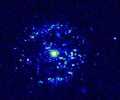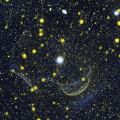Novae
If a binary pair of stars, where one star is a white dwarf, depending on their masses and proximity, the white dwarf may start to accrete gas from companion star. The gas comes from the outer layers, so is predominantly hydrogen and helium. The material becomes spread over, and compacted on, the surface of the white dwarf. It gets compressed and and gets hotter and hotter until the temperature exceeds 2 x 107°K and nuclear fusion starts. If the accretion rate is relatively low, it is possible for the fusion process to be stable. Generally, this fusion process is unstable and results in a runaway reaction producing heavier elements, liberating a massive quantity of energy, enough to eject material into space while producing an enormously bright flash of light . This nova process can occur a number of times as the star continues to accrete mass and blow it off. Under certain circumstances, the rate of accretion can lead to a supernova, as described below.
One example is RS Ophiuchi, which is a recurrent nova, and was known to explode in 1898, 1933, 1958, 1967, 1985, and 2006. A white dwarf and a red giant are in close orbit around each other, with the dwarf star leaching material from the red giant. The image (top right) shows the explosion in February 2006. The lower image is the recurrent nova T Pyxidis. It is a binary pair comprising a white dwarf that is drawing material from a G Type star similar to the Sun. It is known to have exploded in 1890, 1902, 1920, 1944 and 1966, and has steadily increased in mass despite the novae. In about 10 million years it will probably reach the Chandrasekhar Limit, and become a Type 1a supernova, see next section. It is about 3,260 light years from Earth, but moving away.
A luminous red nova is very different to a classic nova. It is an explosion, more powerful than a nova but less so than a supernova, usually resulting from the merging of two stars. The resulting object has a distinct red color, and its light curve decays over a long period; remaining visible for perhaps several weeks or months. Over time, it becomes dimmer in visible light, and stronger in infrared. The intensity of the infrared light dims and brightens several times over an extended period. Several observers contend that this is not a separate class of object, but just a variation on existing supernova explosions. HYPERLINK "/wiki/V838_Monocerotis"The image to the right shows V838 Monocerotis which is a typical example of a luminous red nova.
Like recurrent classical novae, dwarf novae occur in binary pairs where one of the stars is a white dwarf that has periodic bursts of energy; but the mechanism is very different. A dwarf nova results not from accretion of hydrogen, but from instability in the accretion disk. A large amount of matter from the accretion disk then falls onto the white dwarf releasing a large quantity of gravitational potential energy. The luminosity of a dwarf nova is less than that from a classical nova, and typically recurs over periods from days to decades. The luminosity of the outburst increases with longer recurrence intervals and longer orbital periods.
Z Camelopardalis (see right) is a variable star that experiences a type of dwarf nova where the brightness holds temporarily at a level between the maximum and minimum values.
One example is RS Ophiuchi, which is a recurrent nova, and was known to explode in 1898, 1933, 1958, 1967, 1985, and 2006. A white dwarf and a red giant are in close orbit around each other, with the dwarf star leaching material from the red giant. The image (top right) shows the explosion in February 2006. The lower image is the recurrent nova T Pyxidis. It is a binary pair comprising a white dwarf that is drawing material from a G Type star similar to the Sun. It is known to have exploded in 1890, 1902, 1920, 1944 and 1966, and has steadily increased in mass despite the novae. In about 10 million years it will probably reach the Chandrasekhar Limit, and become a Type 1a supernova, see next section. It is about 3,260 light years from Earth, but moving away.
Luminous Red
NovaeA luminous red nova is very different to a classic nova. It is an explosion, more powerful than a nova but less so than a supernova, usually resulting from the merging of two stars. The resulting object has a distinct red color, and its light curve decays over a long period; remaining visible for perhaps several weeks or months. Over time, it becomes dimmer in visible light, and stronger in infrared. The intensity of the infrared light dims and brightens several times over an extended period. Several observers contend that this is not a separate class of object, but just a variation on existing supernova explosions. HYPERLINK "/wiki/V838_Monocerotis"The image to the right shows V838 Monocerotis which is a typical example of a luminous red nova.
Dwarf
NovaeLike recurrent classical novae, dwarf novae occur in binary pairs where one of the stars is a white dwarf that has periodic bursts of energy; but the mechanism is very different. A dwarf nova results not from accretion of hydrogen, but from instability in the accretion disk. A large amount of matter from the accretion disk then falls onto the white dwarf releasing a large quantity of gravitational potential energy. The luminosity of a dwarf nova is less than that from a classical nova, and typically recurs over periods from days to decades. The luminosity of the outburst increases with longer recurrence intervals and longer orbital periods.
Z Camelopardalis (see right) is a variable star that experiences a type of dwarf nova where the brightness holds temporarily at a level between the maximum and minimum values.





